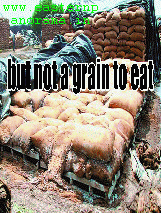Archives
Food Food Everywhere but not a grain to eat
“The puzzle with India is that in India, incomes are rising at the macro level, the GDP is rising all because of technology, IT, mobile phones and all kinds of these types of services. The GDP may go up but malnutrition is also increasing in India because we are not paying attention to the right type of food that we should be eating. In India those who are poor are still very poor and those who are getting rich are getting richer and richer. This is all because of the sources of income and so it is very important that we see where the growth is coming from,” Dr Kwadwo added.
The three day conference organized by the Indira Gandhi National Open University (IGNOU) aims to reach out to farmers in remote and far-flung areas with the latest global information on farming and agriculture.
Tripura’s Chief Minister Manik Sarkar inaugurated the conference in which more than 100 agricultural scientists, experts and delegates from India and abroad participated.
Sarkar emphasised on the location-specific research of agriculture with dissemination of knowledge at the grassroots level to provide food security to the fast growing population with the available fixed resources and to enhance the economic condition of the farmers.
Most of the scientists discussed how various scientific approaches and models of agricultural education can help in capacity building in the agricultural sector.
 Researchers and educators who took part from the different parts of the globe emphasised on effective knowledge management systems for socio-economic development of the agricultural sector.
Researchers and educators who took part from the different parts of the globe emphasised on effective knowledge management systems for socio-economic development of the agricultural sector.
They felt that new sets of courses should be introduced to educate farmers and upgrade their technical and entrepreneurial knowledge so that they can not only get more yield but also produce better products and thus help in proving food security to the world population.
On the Indian agricultural system Dr A K Srivastava, Director, National Dairy Research Institute, Karnal said, “By using only 2.3 percent of the land and 4.2 percent of the global water, India is feeding 17 percent of the total world population. I think in addition to enhancing the agricultural produce, India has to invest, India has to plan the distribution system and minimise the post harvest loss.”
“The extent of grains we are losing at present is because of lack of proper storage. No third world country can afford such loss of food grains where people are hungry. So, in addition to increasing the food grain production we should also tackle post harvest loss. The yield gap which we are seeing at present in our country is one of our biggest strengths. By adopting advanced technologies we can fill this yield gap and it can feed the increasing population of our country,” Dr Srivastava added.
India has moved towards self-sufficiency in food production through the Green Revolution of the 1960s and 70s but the irony is that grains start rotting in the absence of warehouses. There hasn’t been commensurate success in putting money in people’s pockets to buy that food resulting in the poor going hungry.
Dr B.S. Hansra, Professor, IGNOU’s School of Agriculture said, “We have a management system that needs to be improved. In Punjab alone, grains worth Rs 500 crores were spoiled because there was no system to store them. I think we have reached a plateau where we can feed people but we need to streamline the storage system.”
He added, “Every year in India we are wasting Rs 500,000 crores by way of food grain because of this particular problem of storage system. Therefore, my suggestion will be that our government should try to develop a mechanism where the storage facility is at the farmers’ level which can be increased so that the grain they produce can be of use for mankind.”
The speakers and the participants felt that hunger goes beyond poverty and so, to reduce poverty and provide food security, India has to come up with new policies for investing more in educating the farmers of the rural areas so that they are useful partners in economic growth.
Reports say that India was more successful in reducing poverty in the pre-liberalization era when the government had fewer resources to invest than it has been in the high GDP-growth phase since 1990. According to a United Nations World Food Programme report released last year, more than 27% of the world’s undernourished population lives in India with around 43% of children (under 5 years) in the country being underweight — among the highest in the world, higher than sub-Saharan Africa’s figure of 28% and much higher than the global average of 25%.

